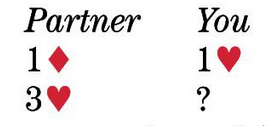Source: ACBL

Cuebids are bids in the opponent’s suit, such as Michaels. There is also a second category of cuebids, however, that are slam-try cuebids. These bids promise a control in the suit named as well as interest in slam. It’s unfortunate that these two share a common name while representing two very different types of bids.
Jeff Rubens, the long-time editor of The Bridge World, has proposed a solution. Bidding a suit as a slam try promises a control in that suit, so he suggested calling it a control bid.
«Marty, why do we have to bother with control bids? We love Blackwood.»
Whenever I hear that complaint, I always reply with «The Great Debate.» The participants: On one side, we have the reigning champion 4NT. On the other, the challenger the control bid.
Degree of difficulty: Bid 4NT now and worry later. No thinking required! Advantage: Blackwood.
Democracy or not? 4NT is like a dictatorship. With control bids, however, both partners are involved in the evaluative process. Advantage: control bid.
Level: 4NT forces you to the five level. Control bids can be made at the four level or lower, and allow you to stop in game if you decide to. Advantage: control bid.
Flexibility: After Blackwood, no more control bids can be made. After control bidding, you can still bid 4NT. Advantage: control bid.
What you find out: 4NT: number of aces (or key cards). Control bid: location.
Game, set, and match to the control bid. The moral of the story: Don’t just close your eyes and bid 4NT. Instead, give control bids a try.
Take a look at this uncontested auction:

Regardless of whether you call it a control bid or a cuebid, everyone agrees that 3![]() :
:
- does not indicate length in spades,
- shows interest in a heart slam,
- promises a control in spades.
What kind of control does 3![]() show? There are two distinct points of view. Some players answer, «It shows first-round control,» meaning the ace or a void. Others would answer, «first- or second-round control,» which means either the ace, king, void or singleton.
show? There are two distinct points of view. Some players answer, «It shows first-round control,» meaning the ace or a void. Others would answer, «first- or second-round control,» which means either the ace, king, void or singleton.
Do I have a decided preference on this topic? Yes.. Let’s look at this hand:
![]() KQ6
KQ6 ![]() AKQ987
AKQ987 ![]() 9
9 ![]() 762.
762.
 Once opener showed 17-19 dummy points, you have points galore. So, what would you bid?
Once opener showed 17-19 dummy points, you have points galore. So, what would you bid?
I know that many players would bid 4NT. Suppose partner bids 5![]() . Then what? If you bid 6
. Then what? If you bid 6![]() because your side has a lot of points and you’re only missing one ace, you won’t be happy when your left-hand opponent leads a club, and partner tables:
because your side has a lot of points and you’re only missing one ace, you won’t be happy when your left-hand opponent leads a club, and partner tables:
![]() A
A ![]() J632
J632 ![]() AK876
AK876 ![]() QJ4. But if you passed 5
QJ4. But if you passed 5![]() , you deserve a dummy where 6
, you deserve a dummy where 6![]() is cold, such as:
is cold, such as:
![]() 872
872 ![]() J632
J632 ![]() AKQ86
AKQ86 ![]() A.
A.
What should you do? Try making a 3![]() control bid, promising a control in spades, and interest in a heart slam. Easy as one, two, three.
control bid, promising a control in spades, and interest in a heart slam. Easy as one, two, three.
I’ve always believed that when you wanted to make a slam try, you showed a control. It didn’t matter whether the control was an ace or a king. If or when partner wanted to know what you have, that’s what Blackwood is for. When I began teaching, I taught that second-round controls were okay to show. Some of my students, however, reported that they were told to «only cuebid aces.»
In Part II we’ll examine control bidding with either first- or second-round controls as this series continues.
